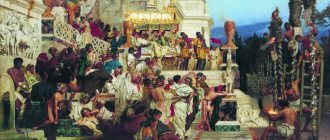Oh, it's easy! We open the Bible and count. The main thing is not to make a mistake in counting and... to know where to read and what to count. And yes, living in 2021, we live 6024 years from creation. I myself have personally calculated this three times already. Here, look and count with me. And if anyone sees a mistake in my work, there are comments below for this, write and we will double-check. (All comments are moderated and do not appear immediately)
So, creation occurred in 4004 BC, and Christ was born in the 4000th year from creation, that is, in 4 years before the birth of Christ! Because, I like to say - BC. This way fewer questions arise.
Why does it work out differently for others?
The Orthodox Church claims a completely different age of the earth. They consider the year 2020 to be 7528 from creation. Why? No, they didn’t count, not even according to the Septuagint. They just pulled the number out of thin air. How? It’s very simple: It is written that with the Lord one day is as a thousand years (2 Peter 3:8). It is also written that Christ is the second Adam (1 Cor 15:45). The first Adam was created in the middle of the sixth day of creation, therefore the second Adam must be born in the middle of the sixth millennium from creation. Logical? And how! And there is no need to count. But since this was invented much later, when there were many different calendars, and it was necessary to carefully calculate, and the year of Christ’s birth itself is not precisely known (today, most historians believe that Christ was born somewhere between the second and seventh year BC), then, when calculating the beginning of our era, a mistake was made, and it turned out that creation was not in 5500 BC, but in 5508 BC. They didn’t change anything - just think, there’s a difference of eight years!
And the Jews, according to their calendar, believe that the year 2020 for the most part corresponds to the 5780th year from creation. But I could not find the calculation of the Jewish chronology - it does not coincide with the Masoretic text of the Bible, or with the chronology of Josephus, or with other calculations known to me. If anyone knows how the Jews calculated their year of creation, I'd love to hear it.
There are other calculations, but I saw in them a discrepancy with one or another Biblical statements. And we will pay close attention to those texts of the Bible that are important to take into account when calculating the chronology.
How did I arrive at 4004 BC as the time of creation? The first time I counted in a notebook with ordinary wooden abacus was on Friday winter evenings, when I returned from school later than my parents had left for evening worship. Then I decided to read the Bible profitably - to calculate the chronology, carefully, taking into account all possible details. Let's repeat this path together with you.
From Adam to the Flood
Everything is simple here: Open the fifth chapter of Genesis and count. But... it should be remembered that in the Septuagint, that is, in the Greek Bible, the numbers in this part of the chronology are completely different. And some after the flood too. Therefore, we count according to the Jewish Masoretic text. This is the canonical synodal translation of the Russian Bible. In the non-canonical synodal text, numbers according to the Septuagint are given in brackets; we ignore them.
| Year from creation | We add | Note | Link |
| 0 | 130 | Adam before the birth of Seth | Gen 5:3 |
| 130 | 105 | Seth before Enosh | Gen 5:6 |
| 235 | 90 | Enos to Cainan | Gen 5:9 |
| 325 | 70 | Kainan to Maleleel | Gen 5:12 |
| 395 | 65 | Malaleel before Jared | Gen 5:15 |
| 460 | 162 | Jared to Enoch | Gen 5:18 |
| 622 | 65 | Enoch before Methuselah | Gen 5:21 |
| 687 | 187 | Methuselah to Lamech | Gen 5:25 |
| 874 | 182 | Lamech before Noah | Gen 5:28 |
| 1056 | 600 | Noah before the flood | Gen 7:11 |
Here we need to stop and make a note, because at this point many inattentive researchers make a mistake of two or three years.
Flood and Sim
Genesis 5:31 says, “Noah was five hundred years old, and Noah begat Shem, Ham, and Japheth.” Simple question: How old was Noah when Shem was born? Simple? No, this is not a simple question, because Shem was not Noah’s firstborn! The Bible lists children not by priority of birth, but by their importance in history. To find out how old Noah was when Shem was born, you should open Shem’s genealogy and read in Genesis 11:10: “Shem was a hundred years old and begat Arphaxad, two years after the flood;” If the Flood was in the year 600 of Noah, and the flood lasted a whole year (Genesis 8:13), then two years after the flood will be in the year 603 of Noah - then Shem was one hundred years old. This means Shem was born when Noah was 503 years old, which means Shem was three years younger than his firstborn! I wonder who was the firstborn? It turns out that Ham, whom Noah cursed. Why? Because in Genesis 10:21 Shem is called the elder brother to Japheth. Ham was the firstborn, who was born in the 500th year of Noah, but due to his sin, the birthright passed to Noah's second son, Shem, who was three years younger than Ham.
But here we need to make one more note. It can make an amendment for one year. It can, but it doesn't necessarily have to. The Bible often speaks in terms of years rather than months. Adam lived 130 years and begat Seth. In what month? How to count these one hundred and thirty years? Today, the next year is considered on the next birthday, and the day before, even one day before the birthday, it is considered that this year does not exist yet. Therefore, there is the concept of “full years” and “incomplete years”. If someone’s birthday is, say, June 1, 2000, then on May 31, 2020, he is still 19 years old, not 20. He will only turn twenty years old on June 1, and before that he is still nineteen. They think so today, but they didn’t think so then. If we understand the inclusive system of Jewish chronology, then we can easily understand the “three days and three nights” of the death of Christ, when Christ died on Friday before sunset and rose again on the first day of the week before sunrise. There were two nights and one day, but where is another night and two days? The essence of the inclusive count is that if part of the first, second and part of the third day is captured, then this is already three days; three calendar days, although not 72 hours, but much less - only about 33 hours Christ was in the grave.
Therefore, although in Genesis 7:11 it is written that “in the six hundredth year of the life of Noah, in the second month, on the seventeenth day of the month” the flood began, and in Genesis 8:13 it is written that “in the six hundred and first year of the first day of the first month” Noah came out of the ark, we do not know for certain whether these are days counted from the birthday of Noah or from the calendar beginning of the year. If this is precisely from the birth of Noah, as stated in Genesis 7:11, then it could be somewhere in the middle of the calendar year, if you count from creation. Therefore, I apply here the inclusive system of counting and believe that the six hundredth year of Noah’s life, in the second month of which the flood began, should be considered the year 1656 from creation, regardless of how complete or incomplete it is. And if anyone disagrees with me on this, then you can minus one year from my calculation - anyway, we will not be able to calculate with an accuracy of up to a month, and all our calculations will be accurate to plus or minus one year.
From the flood to Abraham
So, 1656 is the beginning of the flood, 1657 is the end of the flood, Shem gave birth to Arphaxad two years after the flood - therefore in 1659. From here we continue to count.
| Year from creation | We add | Note | Link |
| 1659 | 35 | Arfaksad to Sala | Gen 11:12 |
| 1694 | 30 | Sala to Eber | Gen 11:14 |
| 1724 | 34 | Ever to Peleg | Gen 11:16 |
| 1758 | 30 | Faleq to Raghav | Gen 11:18 |
| 1788 | 32 | Raghav do Seruh | Gen 11:20 |
| 1820 | 30 | Seruh to Nahor | Gen 11:22 |
| 1850 | 29 | Nahor to Terah | Gen 11:24 |
| 1879 | 205 | Terah before Abraham left Haran | Gen 11:32 |
Here we should make one more stop, because at this point again many inattentive researchers make a mistake similar to the one with Shem, only this time not for two or three years, but for the entire sixty years. So, let's look:
Genesis 11:26 - “Terah lived seventy years and begat Abram, Nahor, and Haran.” The same question: Who is the firstborn, who is the eldest? Abraham? Alas! We read Genesis 11:29 - Nahor's wife was the daughter of Haran. This means that Aran was older than Nahor by the minimum 30-60 years required for his daughter to match Nahor’s age. But Aran comes after Nahor in the list of sons, as if he were younger than Nahor. And all because Aran... died. Even with his father, still in Ur (Gen. 11:28). Aran was the first-born, but did not live to see the championship, so he is listed last.
How many years was Abram younger than Haran? How old was Terah when Abram was born? The answer to this question comes from understanding the events in the lives of Terah and Abram. Genesis 11:31 - Terah migrates from Ur to Canaan, but is forced to stop at Haran due to his health, where he dies in the 205th year of his life (Genesis 11:32). Having buried Terah, Abram continues on his way to Canaan. We understand that Abram did not stay in Haran after the death of his father, but left immediately. At this time Abram was 75 years old (Gen. 12:4). 205-75=130. Therefore, Terah gave birth to Abram at the age of 130, Abram was 60 years younger than Haran, and Nahor was even younger, so Nahor could marry Haran’s daughter.
From Abram to the Exodus from Egypt
So, 1879+205=2084 from creation is the year Abram left Haran to go to the land of Canaan. This year the Lord makes a covenant with Abram (Genesis 12:1-3). Here we could create a New Table to count years and dates. For example, this one:
| Year from creation | We add | Note | Link |
| 2084 | 25 | Haran to Isaac | Gen 17:17 |
| 2109 | 60 | Isaac before Jacob | Gen 25:26 |
| 2169 | 130 | Jacob before Egypt | Gen 47:9 |
In total we get 215 years from Abram's exit from Haran to Jacob's entry into Egypt. And this is where new mistakes begin for inattentive chronology readers. Because they take Genesis 15:13 and add 400 years as the length of time the Jews were in Egypt, ignoring the fact that at that time one generation passed every 40-60 years (that's how long it took for the first child to be born in the average family), and Genesis 15 :16 directly says that “in the fourth generation they will return here.” That is, four generations should be born in Egypt, and this, based on the calculation of 40-60 years per generation, should be approximately between 160 and 240 years, but not 400 years. We take into account that these 400 years were announced to Abram some time after his settlement in Canaan - by this time Abram had already managed to separate from Lot and even managed to save Lot from captivity. This was when the Lord made a covenant with Abram for the second time (Gen. 15:18).
Or maybe all these calculations are unnecessary? Maybe we could do without them? We need these calculations so that we can be convinced of the correctness of another, simpler method. The Apostle Paul has already calculated everything for us: He states that 430 years passed from the promise to Abraham to the appearance of the law at Sinai (Gal. 3:16-17). And we know that the law at Sinai was given only 50 days after the Jews left Egypt, in the same year. We count these 430 (Exodus 12:40-41) years from the first promise to Abram, from the first covenant with him (Gen. 12:3) and to Sinai, to the exit from Egypt. Of these, 215 years, exactly half - the wandering of the patriarchs in Canaan, and the other 215 - four generations in Egyptian slavery. Not four hundred years of slavery, but only 215 years - this is quite consistent with all biblical descriptions. From here we learn that Abram met Melchizedek 30 years after leaving Haran. But these are minor details.
From the Sinai Tabernacle to Solomon's Temple
So, in 2084, Abram left Harran, and 430 years later, that is, in 2514 from creation, the Jews left Egypt and came to the Sinai desert, where they received the law and the command to build a tabernacle for the Lord. And we cannot build a table further - we only know forty years in the desert, but we do not know anything else - neither the time of the conquest of Canaan, nor the time of the judges. We can count the years of Saul and David, but what should we tie them to? And so we read the Bible further...
1 Kings 6:1 - “In the four hundred and eightieth year after the children of Israel came out of the land of Egypt, in the fourth year of the reign of Solomon...he began to build the temple of the Lord.” It turns out that you don’t always need to count. It is important to find the right text in the Bible.
If the exit from Egypt was in 2514 from creation, then the temple began to be built in 2514 + 480 = 2994 from the creation of the world. The temple took seven years to build (1 Kings 6:38), although this is no longer important to us for chronology. But for further calculation, it is better for us to minus four years in order to begin the next table from the beginning of the reign of Solomon. It turns out that Solomon began to reign over Israel in 2990 from creation.
From Solomon to the Babylonian captivity
This is a complex area of chronology because Scripture pays more attention to the chronology of the kingdom of Judah, but the kingdom of Israel is less precisely described. In particular, in the book of Chronicles the kings of Israel are mentioned, but the years of their reign are not indicated at all. In the books of Kings, the years of the reign of the kings of Israel are given, and even in connection with the reign of the kings of Judah, but in total there is about 12 years of discrepancy between the chronology of Judah and the chronology of Israel. One reason for this may be cases of co-government, which are often not described, but which should be clarified from the context. Well, typos and errors of scribes also cannot be discounted.
I review the chronology of this period through the kings of Judah, comparing the records in Kings and Chronicles.
We continue: Solomon reigned in 2990 from creation.
| Year from creation | We add | Note | Link |
| 2990 | 40 | Solomon | 1 Kings 11:42; 2 Par 9:30 |
| 3030 | 17 | Rehoboam | 1 Kings 14:21; 2Chron 12:13 |
| 3047 | 3 | Aviya | 1 Kings 15:2; 2 Chronicles 13:20,21 |
| 3050 | 41 | Asa | 1 Kings 15:10; 2 Par 16:13 |
| 3091 | 25 | Jehoshaphat | 1 Kings 22:41,42; 2Par 20:31 |
| 3116 | 8 | Joram | 2 Kings 8:16,17; 2 Chronicles 21:5,20 |
| 3124 | 1 | Ahaziah | 2 Kings 8:25,26; 2 Chronicles 22:2 |
| 3125 | 6 | Athaliah | 2 Kings 11:3,4; 2 Par 22:12 |
| 3131 | 40 | Joash | 2 Kings 12:1; 2 Par 24:1 |
| 3171 | 29 | Amaziah | 2 Kings 14:1,2,17; 2 Par 25:1 |
| 3200 | 52 | Azariah (Uzziah) | 2 Kings 15:1,2; 2 Chronicles 26:3 |
| 3252 | 16 | Jotham (Jotham) | 2 Kings 15:32,33; 2 Chronicles 27:1,8 |
| 3268 | 16 | Ahaz | 2 Kings 16:1,2; 2 Par 28:1 |
| 3284 | 29 | Hezekiah | 2 Kings 18:1,2; 2 Chronicles 29:1 |
| 3313 | 50 (55) | Manasseh | 2 Kings 21:1; 2 Par 33:1 |
| 3363 | 2 | Ammon | 2 Kings 21:19; 2 Chronicles 33:21 |
| 3365 | 31 | Josiah | 2 Kings 22:1; 2 Par 34:1 |
| 3396 | 0 | Jehoahaz | 2 Kings 23:31; 2 Chronicles 36:2 |
| 3396 | 11 | Joachim | 2 Kings 23:36; 2 Par 36:5 |
| 3407 | 0 | Jehoiachin | 2 Kings 24:8; 2 Chronicles 36:9 |
| 3407 | 11 | Zedekiah | 2 Kings 24:17,18; 2 Chronicles 36:11 |
2 Kings 25:1-10 - in the 11th year of Zedekiah, that is, in 3418 from the creation of the world, Nebuchadnezzar took Jerusalem after an 11-year siege, destroyed the walls of the city, burned the temple and the king’s house, and took the people into captivity. This happened in the 19th year of the reign of Nebuchadnezzar II, in the 5th month, on the 7th day of the month (2 Kings 25:8). This was in July 586 BC.
Babylonian dates today are established with high accuracy due to the linking of all Babylonian events to solar eclipses, which can be calculated mathematically.
3418 + 586 = 4004
The creation of the world took place in 4004 BC! That's what the Bible says.
We calculate the year of birth of Jesus Christ according to the prophecy of the seventy weeks of Daniel (Dan 9:25-27), which says that from the decree of the restoration of Jerusalem to the anointing of Christ the Master there are 69 weeks, that is, 483 years. Christ was baptized (anointed) at the age of 30 (Luke 3:23). We minus these 30 years from 69 weeks: 483-30=453. We count 483 years from 457, which was the decree of Artaxerxes to restore Jerusalem, and this brings us to 4 BC as the year of the birth of Christ.
Today we live in 2021. We add 2021 to 4004 and arrive at the originally stated year of 6024 from the creation of the world.
Vasily Yunak
Historical layers in the Bible
The Bible was composed by various peoples:
- Genesis (1 book of Moses):
- from the Creation of the world to the Flood (from Adam to Noah) - by the pre-Sumerians (Ubadians?), then borrowed by the Jews through the Sumerians and Chaldeans
- from the Flood to Terah - by the Sumerians and Chaldeans
- from Abraham to Moses - the ancestors of the Arabs and Jews
- Exodus (2 books of Moses) - under the leadership of Moses or after him (David?):
- from Moses to David - “Israelites” (core - Sea Peoples, Moses - Armenian (Moscow))
- from David to Christ - Jews
- Leviticus (3 books of Moses) - by Moses himself, or under his leadership
The chronology in the Sumerian Scriptures was based on their system (6-10-60-600-3600...) and when rewritten by Jewish scribes it could be distorted (10-100-1000...)
Biblical reason for historical events
Causes and effects:
- The Persian Empire (Cyrus) was necessary to liberate Jerusalem
- A. Macedonian was necessary for the Hellenization of the East for the subsequent spread of Christianity, and died untimely because he tried to make Babylon the capital of his empire, but Babylon was doomed by God to destruction due to the destruction of Jerusalem
- Rome arose in 753. like the new Judea, captured at this time by Assyria
Igor Garshin, E-mail: [email protected] , URL: . Up: Mythology
As an advertisement (see terms and conditions): skillbox online programming courses. . Find out the latest news from the country and the world on the portal inforakurs.com. Demand I will buy the enterprise.








